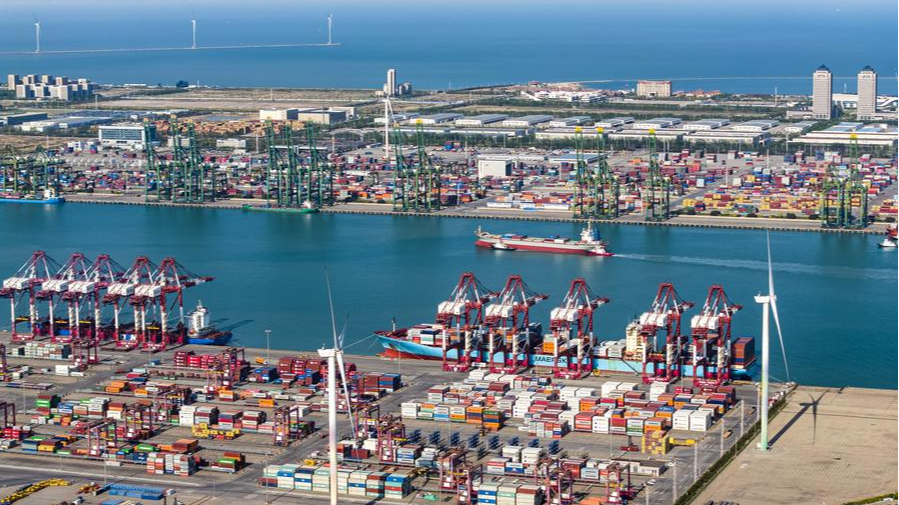A cargo ship navigating at Tianjin Port in north China’s Tianjin, April 25, 2025. /Xinhua
In the bustling city of Hangzhou, east China’s Zhejiang Province, what began as a local marketplace for small merchants has evolved into one of the world’s most dynamic digital ecosystems. Platforms such as Taobao, JD.com and Pinduoduo have transformed the way Chinese consumers shop, while the rise of livestreaming commerce and mobile payment systems has reshaped global perceptions of retail innovation.
During the 14th Five-Year Plan period, China’s digital industry has continued to expand at a remarkable pace, reaching about 35 trillion yuan, or about $4.82 trillion, in total business revenue in 2024. Beyond impressive figures, this digital transformation illustrates how the new development philosophy has guided China toward resilient and inclusive growth in an era of global uncertainty.
The philosophy of innovative, coordinated, green, open and shared development, first proposed at the fifth plenary session of the 18th Central Committee of the Communist Party of China (CPC), represents a shift from a quantity-oriented growth model to one focused on quality and sustainability. It provides a framework through which China has redefined modernization not merely as industrial expansion, but as balanced progress that integrates economic vitality, social well-being and environmental protection.
Innovation, the first pillar, has been the primary driver of China’s transformation. In the digital economy, this has translated into robust investment in research and development (R&D), entrepreneurial dynamism and the rapid application of new technologies such as artificial intelligence, big data and cloud computing.
Over the 14th Five-Year Plan period, China’s R&D spending reached more than 3.61 trillion yuan in 2024, accounting for 2.68 percent of GDP, a record high. The proliferation of digital platforms has not only improved efficiency in commerce and logistics but also created new forms of employment, empowering millions of small businesses and individuals to participate in the national economy.
Equally important is the principle of coordinated development, which emphasizes balanced growth across regions and sectors. The digital economy has narrowed the urban–rural divide by expanding access to markets and services. In 2024, online retail sales in rural areas reached 2.66 trillion yuan, reflecting strong growth in rural consumption and digital inclusion. The development of digital infrastructure has further strengthened this integration, enabling China to foster a more cohesive and adaptive economic structure.
The green dimension of the new development philosophy ensures that progress is achieved within environmental limits. As the world’s largest market for renewable energy and electric vehicles, China’s emphasis on green transition has intertwined with its digital progress.
Smart logistics, energy-efficient data centers and digital monitoring systems have become key tools in optimizing energy consumption and reducing carbon emissions. In 2024, carbon dioxide emissions per 10,000 yuan of GDP fell by 3.4 percent, while clean energy generation rose by 16.4 percent. These figures stand as tangible evidence of how innovation and sustainability can reinforce one another.
A partial view of the Shichengzi photovoltaic power station in Hami City, northwest China’s Xinjiang Uygur Autonomous Region, January 6, 2025. /Xinhua
Meanwhile, the commitment to openness has positioned China as both a participant in and a driver of globalization. Despite global supply chain disruptions and geopolitical headwinds, China has continued to deepen international cooperation in trade, investment and technology.
The establishment of the Hainan Free Trade Port, the continuous expansion of cross-border e-commerce and the country’s active participation in the Regional Comprehensive Economic Partnership all demonstrate a pragmatic pursuit of openness that benefits both domestic and global stakeholders. In 2024, cross-border e-commerce imports and exports grew by 14 percent year on year, highlighting China’s growing role in sustaining global trade flows through digital connectivity.
Finally, shared development anchors these efforts in social inclusion and public welfare. During the 14th Five-Year Plan period, China consolidated its poverty alleviation achievements, expanded social security coverage to over 1 billion people and strengthened the world’s largest education and healthcare systems. In 2024, per capita disposable income increased by 5.3 percent and the urbanization rate rose from 53.1 percent in 2012 to 67 percent, ensuring that the fruits of development continue to reach all citizens and reinforcing social stability, which remains the cornerstone of long-term prosperity.
Together, these five dimensions explain why the new development philosophy has enabled China to maintain high-quality growth even amid external turbulence. The philosophy provides a comprehensive response to the challenges of globalization, technological change and environmental stress. It is not a static model but a dynamic framework that allows China to address external uncertainty with the internal certainty of a well-coordinated and purpose-driven development strategy.
The results are clear. Over the past few years, China has consistently contributed around 30 percent of global economic growth, a figure unmatched by any other major economy. In 2024, the country’s GDP grew by 5 percent year on year, reaffirming its role as a key stabilizer of the world economy. These achievements are not the outcome of short-term stimulus, but of structural progress guided by long-term vision.
As China prepares to embark on the next stage of modernization, the upcoming fourth plenary session of the 20th CPC Central Committee offers an opportunity to consolidate these gains and chart the path forward. The experience of the 14th Five-Year Plan demonstrates that clarity of vision, consistency of policy and confidence in the future are the true sources of certainty in an uncertain world.
Matteo Giovannini, a special commentator on current affairs for CGTN, is a finance professional at the Industrial and Commercial Bank of China, a Non-Resident Associate Fellow at the Center for China and Globalization (CCG) and a member of the Global Young Leaders Dialogue.
cgtn.com




Neben Deutsch kannst Du auch auf Englisch, Spanisch, Französisch, Finnisch, Norwegisch, Portugiesisch und weiteren Sprachen spielen. Anschließend kannst Du das Crab-Spiel starten, bei dem Du
mit Glück Freispiele, Einzahlungsbonus oder andere Belohnungen erhältst.
Deine Daten werden durch moderne SSL-Verschlüsselung geschützt, und alle Transaktionen laufen über sichere Kanäle.
Dabei handelt es sich um eine Art Mini-Spiel, das durch tägliche Einzahlungen aktiviert wird
und verschiedene Boni wie Freispiele, Einzahlungsboni oder Sachpreise ausschüttet.
Darüber hinaus bietet das BassBet Casino Sportspiele wie virtuelle Rennen, sowie exklusive Turniere
mit Leaderboards, bei denen Du gegen andere Spieler
antreten kannst. Die Registrierung bei BassBet Casino ist einfach und schnell.
Die Spieler müssen sich nicht bewerben – sobald sie die erforderliche Stufe erreicht haben,
erhalten sie die entsprechenden Vorteile. BassBet Casino bietet ein strukturiertes VIP-Programm an, das treue Spieler mit exklusiven Vorteilen, persönlichem Support und erhöhten Cashback-Möglichkeiten belohnt.
Die meisten Spielautomaten bei BassBet bieten einen kostenlosen Demomodus, der es den Spielern ermöglicht, sie zu testen, bevor
sie echtes Geld einsetzen. BassBet arbeitet mit
mehr als 60 Softwareanbietern zusammen und bietet so eine vielfältige
Auswahl an Spielen mit unterschiedlichen Themen, Mechanismen und
Auszahlungsstrukturen. Einige Jackpots bieten zufällige Auszahlungen, während andere spezielle Symbolkombinationen erfordern, um den Preis auszulösen.
Im Gegensatz zu Live-Casino-Spielen verwenden Tischspiele RNG-basierte Ergebnisse, die faire und zufällige
Ergebnisse gewährleisten.
So werden Sie schnell Teil der Bass Bet-Community. Klicken Sie auf „Registrieren“ und folgen Sie
den einfachen Schritten. Egal was Sie mögen, das Bass Bet casino hat Unterhaltung für
jeden.
References:
https://online-spielhallen.de/izzi-casino-bonus-codes-ihr-schlussel-zu-extra-spielguthaben-und-freispielen/
Sweet web site, super pattern, really clean and utilise pleasant.
Moin, auf jeden Fall deren Restaurants in Funchal aber auf keinen Fall vom Hotel
besuchen. Gibt’s dort in der Gegend günstige Reiseleitungen für Unternehmungen ?
Welche Seite [ Aussichten) für die Zimmerwal ist den am besten?
Alle Zimmer verfügen über WLAN sowie einen privaten Balkon. Lassen Sie sich in den Restaurants und Bars mit Panoramablick sowie den Tennisplatz nutzen. Das Hotel wurde von Óscar Niemeyer, einem der großen Meister der Weltarchitektur, entworfen. Die angezeigten Preise hängen vom Wechselkurs ab und können sich zum Kaufzeitpunkt ändern.
Das Pestana Casino Studios ist ein Hotel in Funchal auf Madeira, zu Fuß nur fünf Minuten vom Stadtzentrum und dem Mittelpunkt des gesellschaftlichen und kulturellen Lebens entfernt. Der Spielplatz sowie das Kinderspielzimmer laden die Kinder zu Spiel & Spaß ein. Ziehen Sie unbedingt einen Aufenthalt im Wellnessbereich mit Fitnessstudio, Whirlpool, Hammam und Dampfbad in Betracht.
References:
https://online-spielhallen.de/smokace-casino-erfahrungen-mein-umfassender-bericht/